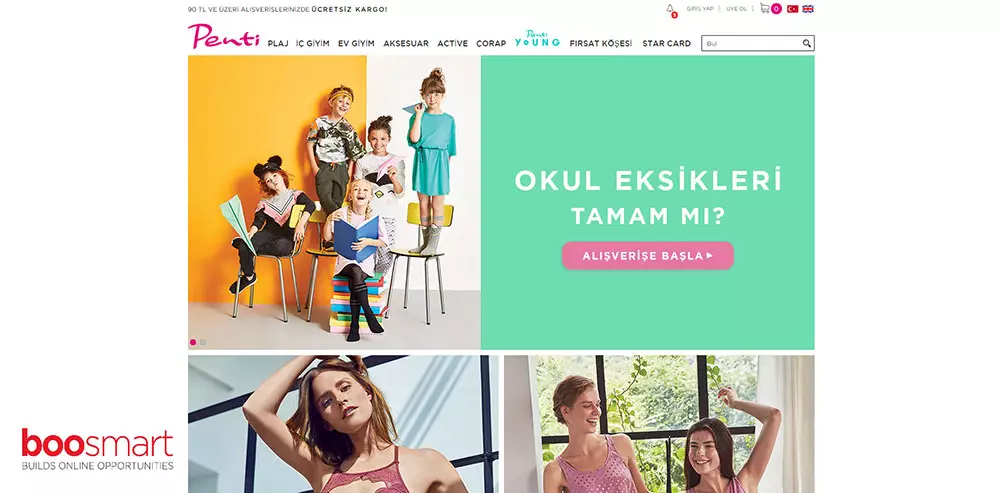
Methodology
About 30% of Penti.com’s traffic is fed by organic traffic and 30% by AdWords traffic. First, we needed to understand how the consumer who came to the website behaved, and we implemented analytics advanced e-commerce integrations with our customer. In this way, we took measures to improve each step and made funnel optimizations to minimize customer loss. By using the onsite search query, we analyzed which products the consumers showed more interest in, and reshaped our site navigation and adwords campaigns.
According to the information we obtained using the Penti.com analytics account, more than 70% of the consumers were coming to the website using at least 2 channels during the purchasing steps. Therefore, we knew that multiple traffic sources contributed to order completion, and we explained the benefits of switching to one of the non-last click models and started using the data-driven attribution model. In this way, we started to better measure the contribution of our traffic sources to conversion.
One of our biggest problems at Penti.com was that we couldn’t get enough shopping ads. We had two different problems. First, the XML feed format was not optimized for Google Shopping (Google Merchant Center), and second, our ROI levels in shopping ads were low. First of all, we made XML feed optimization by working in coordination with our client’s software team. In this way, we have improved the data of our products, such as description and title, which are reflected in the merchant center. In addition, in order to prevent our products that are not in our stock enough and that are close to being sold out during the day, from being reflected in the XML Feed, we ensured that the products above a certain stock quantity are included in the XML feed.
We constantly exchanged ideas with the penti.com team on the importance of omni-channel marketing and multi-device strategy on the retail side. During this period, the Google Turkey team supported us with global research and reviews during the Ecommerce Acceleration program.
We made AdWords Search Conversion Attribution analyzes to make Cross Device Attribution. In the measured figures, we found that the number of conversions with mobile ad interaction and desktop computer as the conversion device, is more than double the number of consumers whose ad interaction is desktop and mobile conversion device. In this way, we improved our strategy on mobile and started using AdWords smart bid strategies in our bid adjustment strategies and started using portfolio bidding strategies such as target Return On Advertising Spend (target ROAS) as a result of ad spend. Thanks to the bid strategies we implemented, AdWords analyzed cross-device interactions, optimized full funnel conversions with machine learning, and our ROAS figures improved by up to 100%.
Innovation
We believed in the importance of synergy between channels in the optimization of social media channels such as Facebook and Instagram. We used the search intend powers of our customers, which we brought from AdWords search and shopping ads campaigns, to improve the performance of our Facebook and Instagram ads. In this way, the performance of our non-Google campaigns has improved up to 300%.
We linked Search Console and AdWords and made continuous optimizations in our XML feed for words that we had at least one engagement in organic but couldn’t find a good enough organic search position. By using the rules feature of Google Shopping (Google Merchant Center), we highlighted our products and product groups with high return on investment (ROI) and high profitability. We tracked paid clicks, organic clicks, combined clicks reports using combined ad and organic statistics report in AdWords. In this way, we have contributed greatly to the brand’s achievement of its profitability targets.
Using the shopping ads reports, we improved the optimization of the order of the products in the listing on the website, we made onpage optimization and landing page optimization. In this way, our conversion rates have increased by up to 70% for all our traffic sources.
By using Google Merchant Center rules, we have made our products and campaigns more prominent in shopping ads, which we need to prioritize.
In order to use the audience targeting feature more effectively in our campaigns, we have created different target audiences in order to make deep audience targeting. Thanks to the Analytics Audience targeting feature, we have created different audiences such as those who browse the product listing pages, those who use the search function, those who list the products from the cheapest to the most expensive, those who look at the products with special offers, those who make purchases, those who abandon their purchases (shopping abandoners). We’ve added these audiences to our AdWords campaigns. We did not use any bid adjustment features and since we used simultaneous bid strategies, AdWords optimized by making higher or lower bids to the relevant audience thanks to machine learning, according to the quality of the audience. In this way, the performance of our shopping ads has improved by up to 350% and the online penetration of the brand has increased.
We improved our competitor analysis process using the Auction insight report. With the insights we gained, we found answers to the questions in which categories we have loss of impression share and in which areas we should invest more. We have set up high priority campaigns on shopping ads for our priority categories and prioritized certain product groups to maximize our revenue from our budget.
Technology
We believed in the importance of synergy between channels in the optimization of social media channels such as Facebook and Instagram. We used the search intend powers of our customers, which we brought from AdWords search and shopping ads campaigns, to improve the performance of our Facebook and Instagram ads. In this way, the performance of our non-Google campaigns has improved up to 300%.
We linked Search Console and AdWords and made continuous optimizations in our XML feed for words that we had at least one engagement in organic but couldn’t find a good enough organic search position. By using the rules feature of Google Shopping (Google Merchant Center), we highlighted our products and product groups with high return on investment (ROI) and high profitability. We tracked paid clicks, organic clicks, combined clicks reports using combined ad and organic statistics reports in AdWords. In this way, we have contributed greatly to the brand’s achievement of its profitability targets.
Using the shopping ads reports, we improved the optimization of the order of the products in the listing on the website, we made onpage optimization and landing page optimization. In this way, our conversion rates have increased by up to 70% for all our traffic sources.
By using Google Merchant Center rules, we have made our products and campaigns more prominent in shopping ads, which we need to prioritize.
In order to use the audience targeting feature more effectively in our campaigns, we have created different target audiences in order to make deep audience targeting. Thanks to the Analytics Audience targeting feature, we have created different audiences such as those who browse the product listing pages, those who use the search function, those who list the products from the cheapest to the most expensive, those who look at the products with special offers, those who make purchases, those who abandon their purchases (shopping abandoners). We’ve added these audiences to our AdWords campaigns. We did not use any bid adjustment features and since we used simultaneous bid strategies, AdWords optimized by making higher or lower bids to the relevant audience thanks to machine learning, according to the quality of the audience. In this way, the performance of our shopping ads has improved by up to 350% and the online penetration of the brand has increased.
We improved our competitor analysis process using the Auction insight report. With the insights we gained, we found answers to the questions in which categories we have loss of impression share and in which areas we should invest more. We have set up high priority campaigns on shopping ads for our priority categories and prioritized certain product groups to maximize our revenue from our budget.

About
penti.com
Penti is Turkey’s leading brand in the categories of socks, underwear and beachwear. With more than 500 physical stores and Penti.com online store, it serves more than 2 million customers every month.
